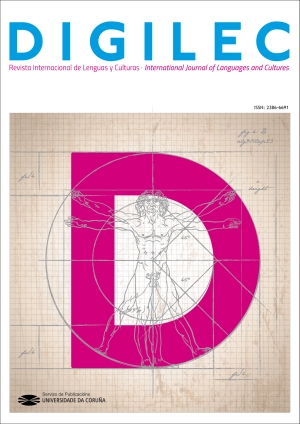Siguiendo las “reglas del juego”: la aleatoriedad e indeterminación como casilla de salida de la composición en el aula
Contenido principal del artículo
DOI:
https://doi.org/10.17979/digilec.2021.8.0.8633Resumen
Esta investigación-acción describe y analiza los resultados de una experiencia educativa basada en la composición e interpretación ante público de una pieza musical basada en los principios de la aleatoriedad y la indeterminación. A través de una inmersión históricamente fundamentada, el alumnado realiza un recorrido por las principales coordenadas estéticas de esta vanguardia, diseñando sus propias partituras mediante notación gráfica. El estudio, llevado a cabo con un grupo de estudiantes de 1º de bachillerato (Galicia, España), se articula en torno a los siguientes objetivos: 1) identificar comportamientos de engagement y participación proactiva; 2) describir y analizar la adecuación idiomática de los productos artísticos; 3) comprobar el grado de asimilación teórico-conceptual; y 4) conocer el grado de aceptación o rechazo de la música aleatoria e indeterminada.
Palabras clave:
Detalles del artículo
Referencias
Barrett, M.S. (2001). Constructing a View of Children’s Meaning-Making as Notators: A Case-Study of a Five-Year-Old’s Descriptions and Explanations of Invented Notations. Research Studies in Music Education, 16(1), 33-45. https://doi.org/10.1177/1321103X010160010401.
Bernstein, D.W. (2014). John Cage's Cartridge Music (1960): A Galaxy Reconfigured. Contemporary Music Review, 33(5-6), 556-569. https://doi.org/10.1080/07494467.2014.998419.
Bröndum, L. (2018). Graphic Notation, Indeterminacy and Improvisation: Implementing Choice Within a Compositional Framework. Open Cultural Studies, 2(1), 639-653. https://doi.org/10.1515/culture-2018-0058.
Buj-Corral, M. (2014). Partituras Gráficas Circulares: Entre Tiempo y Espacio. Barcelona Investigación Arte Creación, 2(3), 277-300. https://hipatiapress.com/hpjournals/index.php/brac/article/view/985.
Castro Alonso, V. (2020). Tras la estela pedagógica de Schönberg: el dodecafonismo como medio de composición musical en el aula de Secundaria. DIGILEC: Revista Internacional de Lenguas y Culturas, 7, 29-48.
https://doi.org/10.17979/digilec.2020.7.0.7104.
Costa, R.L.M. (2009). A idéia de jogo em obras de John Cage e no ambiente da libre improvisaçao. Per Musi, 19, 83-90. https://doi.org/10.1590/S1517-75992009000100009.
Costa, V.F. (2017). O lugar da performance na música indeterminada cageana. Revista Música Hodie, 17(1), 7-18. https://doi.org/10.5216/mh.v17i1.46422.
Frova, A. (2012). Audience reluctance in the face of twentieth century avant-garde music. Rend. Fis. Acc. Lincei, 23, 289-293. https://doi.org/10.1007/s12210-012-0170-8.
Gainza, V.H. (1983). La improvisación musical. Buenos Aires: Ricordi.
Galian-Gallach, J.L. (2018). De la naturaleza de la improvisación libre: elementos esenciales para su identificación y diferencias con la composición escrita. ITAMAR. Revista de Investigación Musical: Territorios para el Arte, 4, 26-49. https://ojs.uv.es/index.php/ITAMAR/article/view/12880.
García-Fernández, I.D. (2018). Estrategias para el análisis de la música visual: el caso de Llorenç Barber. En Musicología en el siglo XXI: nuevos retos, nuevos enfoques, B. Lolo y A. Presas (eds.), 1769-1785. Madrid: Sociedad Española de Musicología.
Hogenes, M., Oers, B., Diekstra, R.F.W., y Sklad, M. (2016). The effects of music composition as a classroom activity on engagement in music education and academic and music achievement: A quasi-experimental study. International Journal of Music Education, 34(1), 32–48. https://journals.sagepub.com/doi/abs/10.1177/0255761415584296.
Kemmis, S. y McTaggart, R. (1987). Cómo planificar la investigación-acción. Barcelona: Laertes.
López-Rodríguez, J.M. (2008). Aprendiendo a través de la indeterminación. LEEME, 22, 1-14. https://ojs.uv.es/index.php/LEEME/article/view/9776.
Paynter, J. (1999). Sonido y estructura. Madrid: Akal
Schafer, R. M. (1986). El compositor en el aula. Buenos Aires: Ricordi.
Viig, T. (2019). There is a shark coming, then there is a du-du-du-du-du...: Mediating cultural tolos in a Norwegian creative music-making Project. British Journal of Music Education, 36(2), 125-138. https://doi.org/10.1017/S026505171900007X.
Weeks, T. (2016). Mastering musical meaning: images as interpretive resources in multimodal music texts. Visual Communication, 15(2), 221-250. https://doi.org/10.1177/1470357215622737.
Zaragozá, J. L. (2009). Didáctica de la música en la educación secundaria. Competencias docentes y aprendizaje. Barcelona: Graó.


